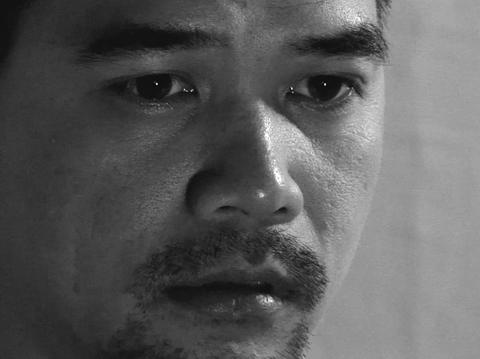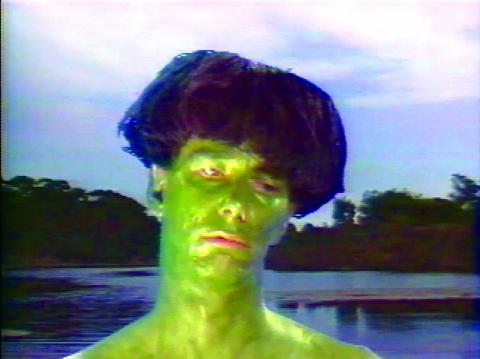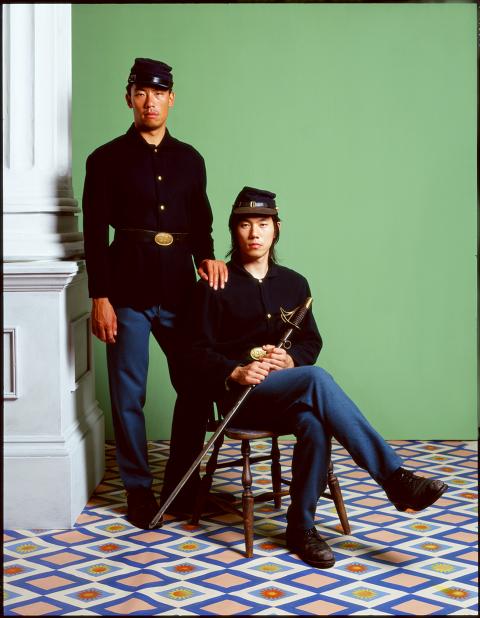On a number of home movie screens assembled to form one large screen, footage from World War II movies from the era depict Japanese as brutes and killers. Across from it, an old TV set plays a compilation of commercials from the 1950s.
The video installation, titled Environmental, serves as a telling introduction to An Asian Survey — Bruce Yonemoto (亞洲調查 — 布魯斯米本個展), the first solo exhibition of Japanese-American artist Bruce Yonemoto in Taiwan, currently on view at Hong Gah Museum (鳳甲美術館).
A multimedia artist and art professor, Yonemoto is noted for exploring issues of representation, identity and memory. His focus is on mass media, its pervasive manipulation of reality and fantasy and how it constantly constructs, formulates and mutually informs our desires and notions of identity, both personal and collective.

Photo courtesy of Hong Gah Museum
For Yonemoto, such topics are not abstract. He was born in the immediate post-World War II period and grew up in California. His parents were among the more than 120,000 Japanese-Americans incarcerated in internment camps during the war, and, following the war, re-assimilated into American society.
Environmental (2013) reflects on the artist’s childhood in the 1950s, a time when “every family had a screen at home to watch home movies or slide shows.”
“That is the immediate environment in which I was raised as a child, which, of course, was a very perverse environment because the Japanese were villains. They were the enemies,” Yonemoto says. “But what can I do? I was just a child watching TV.”

Photo courtesy of Hong Gah Museum
Yonemoto began his artistic career in the 1970s working with his brother Norman Yonemoto, who recently passed away. Their collaborations, which took place over the course of two decades, saw the Yonemoto brothers create an impressive array of films and video works that often appropriated the visual vernacular of Hollywood melodrama, television advertising and other popular forms to expose, deconstruct and subvert mass-media archetypes and cliches.
Kappa (1986), for example, is a provocative video that takes an ironic and sometimes hilarious look at Sigmund Freud’s psychosexual development theory by juxtaposing the Oedipal myth with the legend of kappa, a mischievous Japanese water imp.
The work stars Mike Kelley, an American contemporary artist who committed suicide in 2012, as the kappa. American actress and painter Mary Woronov plays a mother/vamp figure — one that wouldn’t look out of place in a Hollywood exploitation movie.

Photo courtesy of Hong Gah Museum
“But it you apply Freud’s psychoanalysis to the kappa myth, it becomes very comic very quickly. Kappa’s favorite food is cucumber, and he molests young girls in the toilet. All these things are very Freudian cliches,” the Los Angeles-based artist says.
In the small retrospective in Taipei, Yonemoto’s examinations on the interplay between American pop culture and pan-Asian identities create an intriguing motif.
NSEW (2007) is a series of photographs that examine a part of American civil war history that is largely excluded from official texts and public consciousness. The large photographs depict Asian men posing as soldiers fighting during the war in an act that restores them to the historical record. The costumes were rented from the oldest Hollywood costume supplier, Western Costume, whose collection of civil war uniforms were used in American director DW Griffith’s 1915 infamously racist film, Birth of a Nation.

Photo courtesy of Hong Gah Museum
Close to home, Enka (2015) is a collaborative project between Yonemoto and a group of Taiwanese artists including performance artist Huang Da-wang (黃大旺) and Freya Chou (周安曼), who curates this show.
The collaboration was initiated in 2013 when Yonemoto first visited Taipei, and is driven by the interest in finding out how “Japanese culture is incorporated into Taiwanese culture.” One day, the artist took a cab to Beitou District (北投) and heard a familiar sound playing on the radio. It was a Hokkien ballad, and what struck Yonemoto as familiar is the melody that derives from enka, a popular genre of music in Japan.
Originally used as a form of political dissent during the Meiji period (1868 to 1912), enka eventually became sentimental songs about lost love and life on Taiwan during the colonial era.

Photo courtesy of Hong Gah Museum
Yonemoto’s Enka is an attempt to revive the political origins of the musical form. Several artists were invited to make their own political statements by rewriting the lyrics for the Hokkien song Mum, please take care too (媽媽請你也保重).
Contemporary artist Yu Cheng-ta (余政達), for example, sings about Taiwan’s unsettled international status with multimedia artist Chen Yin-ju (陳瀅如), while curator Ray Hsu (許峰瑞) uses the song to recall the history of Losheng (Happy Life) Sanatorium (樂生療養院), a leprosarium built under the Japanese colonial government.
Yonemoto says his art has always been political.
“But I try to make it more metaphoric, ambiguous… There is always a humor to it,” he says.

On April 26, The Lancet published a letter from two doctors at Taichung-based China Medical University Hospital (CMUH) warning that “Taiwan’s Health Care System is on the Brink of Collapse.” The authors said that “Years of policy inaction and mismanagement of resources have led to the National Health Insurance system operating under unsustainable conditions.” The pushback was immediate. Errors in the paper were quickly identified and publicized, to discredit the authors (the hospital apologized). CNA reported that CMUH said the letter described Taiwan in 2021 as having 62 nurses per 10,000 people, when the correct number was 78 nurses per 10,000

As we live longer, our risk of cognitive impairment is increasing. How can we delay the onset of symptoms? Do we have to give up every indulgence or can small changes make a difference? We asked neurologists for tips on how to keep our brains healthy for life. TAKE CARE OF YOUR HEALTH “All of the sensible things that apply to bodily health apply to brain health,” says Suzanne O’Sullivan, a consultant in neurology at the National Hospital for Neurology and Neurosurgery in London, and the author of The Age of Diagnosis. “When you’re 20, you can get away with absolute

May 5 to May 11 What started out as friction between Taiwanese students at Taichung First High School and a Japanese head cook escalated dramatically over the first two weeks of May 1927. It began on April 30 when the cook’s wife knew that lotus starch used in that night’s dinner had rat feces in it, but failed to inform staff until the meal was already prepared. The students believed that her silence was intentional, and filed a complaint. The school’s Japanese administrators sided with the cook’s family, dismissing the students as troublemakers and clamping down on their freedoms — with

As Donald Trump’s executive order in March led to the shuttering of Voice of America (VOA) — the global broadcaster whose roots date back to the fight against Nazi propaganda — he quickly attracted support from figures not used to aligning themselves with any US administration. Trump had ordered the US Agency for Global Media, the federal agency that funds VOA and other groups promoting independent journalism overseas, to be “eliminated to the maximum extent consistent with applicable law.” The decision suddenly halted programming in 49 languages to more than 425 million people. In Moscow, Margarita Simonyan, the hardline editor-in-chief of the